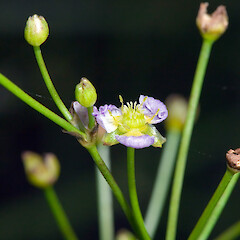Alisma lanceolatum
Common name
water plantain
Family
Alismataceae
Flora category
Vascular – Exotic
Structural class
Herbs - Monocots
NVS code
The National Vegetation Survey (NVS) Databank is a physical archive and electronic databank containing records of over 94,000 vegetation survey plots - including data from over 19,000 permanent plots. NVS maintains a standard set of species code abbreviations that correspond to standard scientific plant names from the Ngä Tipu o Aotearoa - New Zealand Plants database.
ALILAN
Conservation status
Not applicable
Brief description
A marginal aquatic plant, with lance-shaped leaves, with many tiny pink flowers held on a pyramid-shaped inflorescence, much taller than the rest of the plant.
Distribution
Scattered in Hawke’s Bay, Wellington and Canterbury.
Habitat
Margins of still and slow flowing water bodies and wetlands.
Wetland plant indicator status rating
Information derived from the revised national wetland plant list prepared to assist councils in delineating and monitoring wetlands (Clarkson et al., 2021 Manaaki Whenua – Landcare Research Contract Report LC3975 for Hawke’s Bay Regional Council). The national plant list categorises plants by the extent to which they are found in wetlands and not ‘drylands’. The indicator status ratings are OBL (obligate wetland), FACW (facultative wetland), FAC (facultative), FACU (facultative upland), and UPL (obligate upland). If you have suggestions for the Wetland Indicator Status Rating, please contact: [Enable JavaScript to view protected content]
OBL: Obligate Wetland
Almost always is a hydrophyte, rarely in uplands (non-wetlands).
Detailed description
Leafy emergent perennial herb up to c. 1 m high, although non-flowering plants are much shorter. Aerial parts die off over winter to the rootstock. Leaves all basal, broad ovate 7-23 (28) × 2-5 cm, with a tapered base with a long petiole up to or exceeding the leaf blade. Petiole is semi-circular in cross-section (D-shaped). Submerged or floating leaved plants sometimes occur, these have narrower than emergent leaves. Inflorescence a large, much-branched panicle; branches whorled. Flowers usually pale lilac, c. 1 cm across. C. 20 rounded and flattened seeds (achenes) c. 2.5 mm long, in a dense circular head.
Similar taxa
Alisma plantago-aquatica has broader lance-shaped leaves and lilac rather than pink coloured flowers. Sagittaria platyphylla has larger flowers on a smaller inflorescence and triangular petioles.
Flowering
Summer
Flower colours
Red/Pink
Fruiting
Summer to autumn
Life cycle
Spreads by waterfowl and water dispersed seed.
Year naturalised
1895
Origin
Native to Europe, North Africa and West Asia.
Reason for introduction
Possibly ornamental pond plant, or a seed or soil contaminant.
Control techniques
Rarely problematic and normally controlled in New Zealand.
Attribution
Prepared by Paul Champion and Deborah Hofstra (NIWA).
References and further reading
Clapham, A.R.; Tutin, T.G.; Warburg, E.F. (1962). Flora of the British Isles. Cambridge University Press, Second Edition. 1269pp.
Croasdale, H., Flint E. A. and Racine, M. M. (1994). Flora of New Zealand Volume 3: Freshwater algae, chlorophyta, desmids with ecological comments on their habitats, Staurodesmus Staurastrum and the Filamentous desmids. Manaaki Whenua Press: Lincoln, New Zealand.
Johnson PN, Brooke PA (1989). Wetland plants in New Zealand. DSIR Field Guide, DSIR Publishing, Wellington. 319pp.
Preston, C.D.; Croft, J.M. (1997). Aquatic plants in Britain and Ireland. Harley Books, 365pp.











